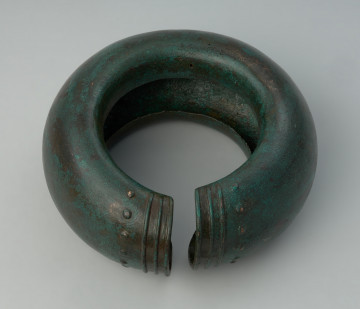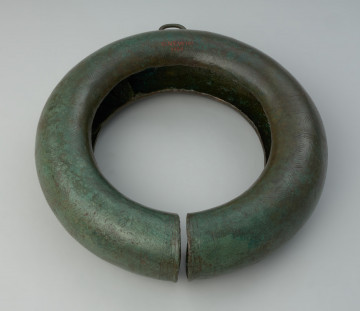
A knee-cap, an empty knee-cap, a rim
around 600 p.n.e. — 400 p.n.e.
National Museum in Szczecin
Part of the collection: Bronze Age
The bracelet was a part of a substantial hoard of bronze ornaments discovered in Gniewino in 1885. The first part of the hoard was found in spring during fieldwork, and the other part got discovered the same year in summer. Allotted to various museums, it consisted of approx. 20 items in total, among which were the anklets, bracelets, and a neck-ring.
The bracelet was cast around a clay core, which was later removed trough a crevice seen around the bracelet. A distinctive feature of this type of decoration is a protrusion shaped like a kidney placed in the middle of the bracelet. The whole deposit can be dated to the Early Iron Age (the so-called Hallstatt D period, 600/550–450/400 BC) and associated with the population of the Pomeranian culture. Intriguingly, more deposits discovered in the Western Pomerania can be associated with this period than with the predeceasing one. The contents of deposits also changed – the number of tools decreased, the weaponry elements almost disappeared, and the first iron objects begun to appear, while bronze jewellery was represented mainly by ring ornaments.
Monika Witek
Author / creator
Dimensions
the entire object: height: 11 cm, diameter: 12 cm
Object type
bangle (hoop), body adornment
Technique
casting
Material
bronze
Origin / acquisition method
legal transfer
Creation time / dating
Creation / finding place
Owner
National Museum in Szczecin
Identification number
Location / status

around 600 p.n.e. — 400 p.n.e.
National Museum in Szczecin

around 600 p.n.e. — 400 p.n.e.
National Museum in Szczecin

900 p.n.e. — 550 p.n.e.
National Museum in Szczecin
DISCOVER this TOPIC
National Museum in Szczecin
DISCOVER this PATH
Educational path